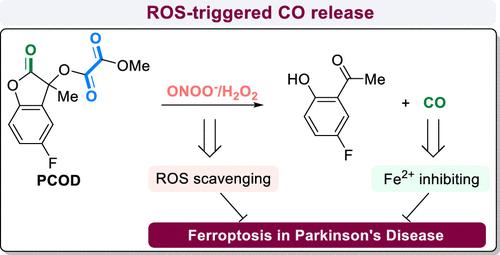Synergistic Anti-Ferroptosis with a Minimalistic, Peroxide-Triggered Carbon Monoxide Donor for Parkinson’s Disease
IF 6.8
1区 医学
Q1 CHEMISTRY, MEDICINAL
引用次数: 0
Abstract
Parkinson’s disease (PD) is a debilitating neurodegenerative disease, with current treatments primarily focusing on improving dopaminergic activity, providing symptomatic relief but failing to halt disease progression. Ferroptosis drives PD pathogenesis and is a potential therapeutic target. Herein, we introduce a novel peroxide-activated carbon monoxide (CO) donor, PCOD, featuring a streamlined structure designed to potentially enhance blood-brain barrier (BBB) penetration and optimize therapeutic outcomes. PCOD releases CO upon activation by nucleophilic peroxides, e.g., ONOO– and H2O2. This mechanism provides a potent strategy against ferroptosis: first, scavenging peroxides that generate oxidative radicals involved in ferroptosis, and second, CO is proposed to inhibit Fenton chemistry through coordination to Fe2+. In MPTP-treated mice, PCOD prevents dopaminergic neuron loss in the substantia nigra and alleviates PD symptoms. This peroxide-triggered CO release offers a promising and innovative strategy to combat ferroptosis and neurodegeneration in PD.

协同抗铁下垂与极简,过氧化物触发一氧化碳供体帕金森病
帕金森病(PD)是一种使人衰弱的神经退行性疾病,目前的治疗主要集中在改善多巴胺能活性,提供症状缓解,但未能阻止疾病进展。上睑下垂驱动PD发病机制,是潜在的治疗靶点。在此,我们介绍了一种新型的过氧化物活性碳(CO)供体PCOD,其流线型结构旨在潜在地增强血脑屏障(BBB)渗透并优化治疗效果。PCOD在被亲核过氧化物(如ONOO -和H2O2)激活后释放CO。这一机制提供了一种有效的对抗铁死亡的策略:首先,清除产生参与铁死亡的氧化自由基的过氧化物,其次,CO被提出通过与Fe2+配合来抑制Fenton化学。在mptp处理的小鼠中,PCOD可防止黑质多巴胺能神经元丢失,减轻PD症状。这种过氧化氢触发的一氧化碳释放提供了一种有前途的创新策略来对抗PD中的铁下垂和神经退行性变。
本文章由计算机程序翻译,如有差异,请以英文原文为准。
求助全文
约1分钟内获得全文
求助全文
来源期刊

Journal of Medicinal Chemistry
医学-医药化学
CiteScore
4.00
自引率
11.00%
发文量
804
审稿时长
1.9 months
期刊介绍:
The Journal of Medicinal Chemistry is a prestigious biweekly peer-reviewed publication that focuses on the multifaceted field of medicinal chemistry. Since its inception in 1959 as the Journal of Medicinal and Pharmaceutical Chemistry, it has evolved to become a cornerstone in the dissemination of research findings related to the design, synthesis, and development of therapeutic agents.
The Journal of Medicinal Chemistry is recognized for its significant impact in the scientific community, as evidenced by its 2022 impact factor of 7.3. This metric reflects the journal's influence and the importance of its content in shaping the future of drug discovery and development. The journal serves as a vital resource for chemists, pharmacologists, and other researchers interested in the molecular mechanisms of drug action and the optimization of therapeutic compounds.
 求助内容:
求助内容: 应助结果提醒方式:
应助结果提醒方式:


